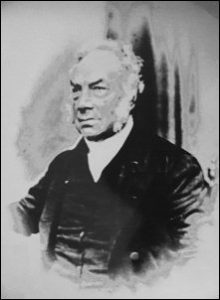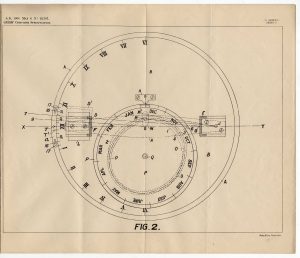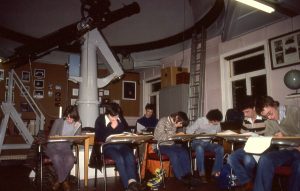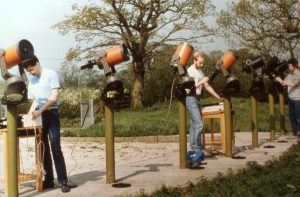Astronomy in Preston and UCLan goes back to the establishment of the Preston Institution for the Diffusion of Knowledge. One of its founders was Moses Holden who gave public talks on astronomy for many years in Preston and surrounding areas. Through his legacy in forming the institution UCLan has been dedicated to bringing knowledge to the public. This is seen at outreach events at the university and public trips to Alston Observatory hosted by UCLan and the Jeremiah Horrocks Institute.
Here is highlighted information about historically significant astronomers and observatories that reside in the Preston area.
Jeremiah Horrocks (1619-1641)
Jeremiah Horrocks was born in Toxteth, an outlying village near Liverpool in 1619. He died on the morning of January 3rd 1641. He went to Cambridge University at the age of 13 as a Sizar (poor scholar) and left four years without taking a degree. This was common practise during those days since many who did return took their degree examinations later after earning the money to pay for the examination process.
Jeremiah Horrocks was a Lancastrian who became “The Father of English Astronomy”. It is for him that the Jeremiah Horrocks Institute at UCLan is named. Little is known about him in great detail. He studied astronomy as an extra curricular activity in school and became fascinated by it. He was a capable mathematician and used home-made instruments to observe the Moon and the planet Venus. He studied European Astronomy and followed the works of eminent European scholars such as Nicholas Copernicus, Tycho Brahe, Johannes Kepler and Galileo Galilei. Using theories and his own observations, he demonstrated Kepler’s Laws of Planetary Motion were correct and that both Mars and the Moon followed elliptical orbits. He expanded on Kepler’s astronomy and studied mathematically the force of Gravity (Isaac Newton was not born until 1642).
Working on Kepler’s prediction that the planet Venus would transit, or pass across the face of the Sun in 1631 and again in 1761, he calculated that this would also occur on the 24th of November 1639. He then both observed it for himself, but also convinced William Crabtree of Salford to confirm his observation. His observation of the transit lasted only half an hour. Combined with previous and following observations, he was able to conclude that Venus had an elliptical orbit between the Earth and the Sun. This was achieved with home-made instruments and a telescope which at the time cost the equivalent of 12.5p.
Jeremiah Horrocks observed the transit of Venus at Much Hoole near Preston in 1639. Subsequent transits were observed from various locations, and expeditions were dispatched to make observations as far apart as possible. The transit of 1761 was observed by Charles Mason and Jeremiah Dixon at the Cape of Good Hope. Modern astronomers use more sophisticated methods to determine distances within the Solar System. Nevertheless, transits remain fascinating astronomical spectacle
His work was well received by the scientific establishments of Britain and Europe. His work influenced famous names that followed his work. These include Sir Isaac Newton and John Flamsteed (the first Astronomer Royal) as well as European scholars and helped put English Astronomy at the forefront of European Science.
Moses Holden (1777-1864)
Moses Holden was born in Bolton on November of 1777. In his early days, he worked in a foundry, but he met with an accident. After recovery, he took up landscape gardening for a while and became a hand-loom weaver. He was also passionate about astronomy and collected many astronomy books. He was one of the Founders of the Preston Institution for the Diffusion of Knowledge in 1828, which went on to become the University of Central Lancashire. Moses was a keen Astronomer, who gave public lectures in Astronomy in Preston and across the North of England and the Midlands throughout the 19th Century. He also popularised astronomy in the early 19th century via books and lectures.
He was eventually able to devote the whole of his time to teaching and lecturing about astronomy. He wrote and published his celestial Atlas entitled “A small Celestial Atlas, or Maps of the Visible Heavens, in the Latitude of Britain”. During those time, astronomy books were expensive and his pamphlets were one of the earliest works of the kind published at a low price. He also compiled an Astronomical Almanac, the first of which was published in 1835 with a copy in UClan’s Library. He was entirely self taught and a highly respected as an authority on astronomy. He was a member of the Mechanics’ Institute and made telescopes and microscopes, even grinding his own lenses.
Moses Holden became successful as a lecturer and accomplished much in the way he presented his subject to the public. He gave his first lecture at the Theatre Royal in Preston in 1815. To aid his lectures, he constructed a large orrery (a mechanical model of the Solar System based on a heliocentric design). and used an ingenious magic lantern (an early type of image projector, where pictures or photographs were painted on sheets of glass and the image is projected using a lens and a bright light source). He used these to illustrate his astronomy lectures, such as the motions of the Earth, the Moon and the planets in the Solar System. He projected an image of the orrery onto a large screen and filled theatres with enthusiastic members of the public, who paid to hear about the latest advances in astronomy. Moses Holden was a skilled mechanic and most of the demonstration material he used was constructed by himself. He toured all over the north of England giving lectures and demonstrating his orrery
The University of Central Lancashire owes its foundation to a meeting of 24 townspeople on October 7th 1828, at which they agreed to create ‘The Preston Institution for the Diffusion of Knowledge’. One of the founders was listed as ‘Moses Holden, Gentleman’. Moses Holden gave his first lecture at the Preston Institution for the Diffusion of Knowledge in 1828 on optics.
In 1826 he devoted the proceeds of one of his lectures to the erection of a monument in St. Michael’s Church, Toxteth, Liverpool, to the memory of Jeremiah Horrocks.
Moses was a devout Methodist all of his life. He saw no contradiction between science and religion. In fact, he saw his astronomical discoveries as simply uncovering the works of God. He often gave sermons in church, and was selected to lead an evangelical mission to the Fylde peninsula. He carried out a series of fortnightly visits all over the Fylde peninsula, preaching in numerous towns and villages as he went. The Fylde peninsula was much more sparsely populated in Moses’ day than it is today. He ran bible groups and Sunday schools, and was connected with Christ Church, Preston. He provided the correct time for the clock for Christ Church, which is now in County Hall.
Moses Holden died in 1864.
George James Gibbs (1866-1947)
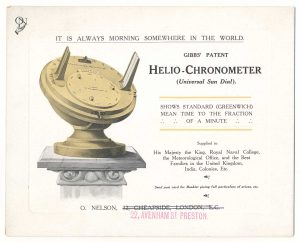 George James Gibbs was born in 1866 in London and later became a private engineering consultant in Preston and acted as a consulting engineer for numerous industrial projects for the supply of water and energy in Lancashire. He was was an astronomer, engineer, inventor and public science lecturer and became a fellow of the Royal Astronomical Society (elected on 12 January 1912) and a member of the Institution of Engineers. He was born
George James Gibbs was born in 1866 in London and later became a private engineering consultant in Preston and acted as a consulting engineer for numerous industrial projects for the supply of water and energy in Lancashire. He was was an astronomer, engineer, inventor and public science lecturer and became a fellow of the Royal Astronomical Society (elected on 12 January 1912) and a member of the Institution of Engineers. He was born
Mr Gibbs went into partnership with William Renard Pilkington to form Messrs Pilkington & Gibbs Ltd. Within this partnership, George James Gibbs invented the Heliochronometer. Gibbs therefore provided the idea and Pilkington the finance and they both went on to patent the idea. The partnership was subsequently dissolved and the last Heliochronometer was made around 1914.
Gibbs patent is a sundial called the Universal Equinoctial Mean Time Heliochronometer or Gibbs Heliochronometer for short—which was able to accurately determine GMT to within a minute at any time of the year and at any latitude. This was adjusted at the Pilkington-Gibbs factory for the latitude and the longitude of the purchaser
In 1910, George James Gibbs became an honorary curator of the Deepdale Observatory. He continued to hold the position of Honorary Curator (later Chief Observer) for the rest of his life at Deepdale Observatory and later the Jeremiah Horrocks Observatory.
Gibbs was part of an RAS expedition to Hernosand, Sweden to photograph and study the solar eclipse of August 1914 along with Fathers Cortie SJ and O’Connor SJ. They were originally meant to be part of a larger expedition to Kiev but the Russians denied them entry due to their ban on Jesuits. The Great War broke out as they were away and a British Naval cruiser had to collect the party and return them home after they had made their observations.
He continued to hold the position of Honorary Curator (later Chief Observer) for the rest of his life. He was active in both observations and maintenance up until a couple of months before his death on the 22 February 1947
Deepdale Observatory (1881 – 1927)
Deepdale observatory opened in Deepdale park between Deepdale Road and East View in October 8th 1881 and was run by the Preston Scientific Society (of which George James Gibbs became president of in 1902). In 1912, he managed to persuade Preston Corporation to spend £200 to buy from the estate of the late Mr. Garnet (a Clitheroe mill owner), an 9 inch refracting telescope. This was built by a firm of optical instrument manufacturers, THOMAS COOKE & SONS of York. The telescope was placed in Deepdale Observatory for serious observation of binary stars, the planets and the moon. Unfortunately much of the archive material for this instrument has been lost. It was believed to be made in 1867 and was amongst the first of a much larger set of telescopes by THOMAS COOKE & SONS. 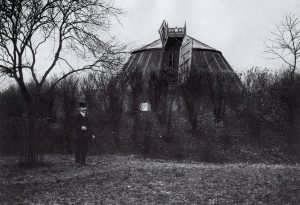
The Deepdale Observatory (known as the Preston Municipal Observatory) was in a state of disrepair as early as 1914. Unfortunately planning for a replacement was unable to occur until after the war. Gibbs began to draw up designs and find a suitable location for a new observatory and chose a site at the north side of Moor Park. It was named “The Jeremiah Horrocks Observatory‟ after Jeremiah Horrocks himself. Deepdale Observatory was closed down at the same time as the opening of the Jeremiah Horrocks Observatory on the 29th June 1927 after the telescope was dismantled and reassembled at the Jeremiah Horrocks Observatory. An inscribed stone now marks its original spot. George James Gibbs who was the honorary curator from 1910 continued on with this role at the new Jeremiah Horrocks Observatory.
Moor Park Observatory (1927-2002) (2017-)
Moor Park Observatory (known then as the Preston Municipal Observatory but also the Jeremiah Horrocks Observatory) opened on the 29th June 1927. George James Gibbs designed and curated the observatory for over 20 years. The opening of the observatory coincided with the solar eclipse on that day and thousands of locals went to Moor Park to observe it. The telescope that was used at Deepdale Observatory, and then the Jeremiah Horrocks Observatory (which still resides there today) is an 8-inch refractor built in 1860. The Jeremiah Horrocks Observatory provided space for public lectures on astronomy and became popular in the region which attracted visitors from around the country. 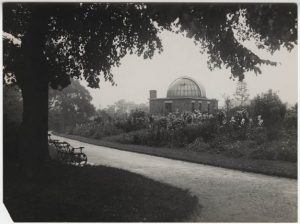
The 1927 Eclipse passed over Preston and was observed from the Jeremiah Horrocks Observatory. In general this became the site of astronomy teaching related activities for the Institution for the Diffusion of Knowledge (what later became UCLan).
When George James Gibbs died on February 22 1947. The observatory was taken over by the Preston Council’s Education Department which appointed Professor Vincio Barocas as Director in July 1949 until his retirement in August 1979, when it was taken over by Dr. Keith Robinson.
Durring his tenure, Professor Barocas founded the Wilfred Hall observatory at Alston Hall (located near Preston). This eventually became the main teaching centre for Astronomy and Astrophysics at the University of Central Lancashire, although the Jeremiah Horrocks Observatory was still being used to teach first year students up to 1995. The observatory was regularly visited by schools from throughout the Preston area as well as a wide variety of of groups and individuals, especially on public open nights which were held on Thursdays between September and March every year. 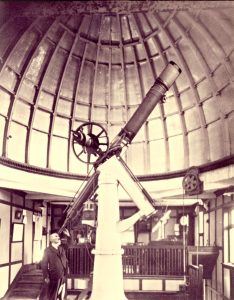
In 1953, the Preston District Amateur Astronomy Society (PADAS) formed. The second Thursday of every month between September and June was the meeting night of the PADAS when visiting speakers came to give talks on a wide variety of subjects in Astronomy. On open nights, telescopes were in use and PADAS members were on hand to aid members of the public with observations. PADAS also hosted public observational events for the comets Hale-Bopp and Hyukate.
Due to the expansion of the city of Preston the Moor Park site was no longer fit for operation due to light pollution. In 1957 the Royal Astronomical Society placed on long term loan to Preston the Wilfred Hall telescope which has since expanded to become the Alston Observatory home of the new, 70cm Reflector, Moses Holden Telescope.
The Jeremiah Horrocks Observatory celebrates it’s 90th Anniversary in 2017. The observatory closed in 2002, but was reopened in 2017.
Alston (Wilfred Hall) Observatory (1957-)
Wilfred Hall Observatory (now known as the Alston Observatory) opened in 1957.
The UMIST/Preston multiple-mirror telescope, also known as the Multiple-Aperture Telescope (MAT) was installed. This was a joint project between the Division of Physics and Astronomy of Preston Polytechnic and the Department of Pure and Applied Physics at the University of Manchester Institute of Science and Technology. At the time, this was a revolutionary new concept for a compact and inexpensive optical telescope which could take photometric and spectroscopic images. 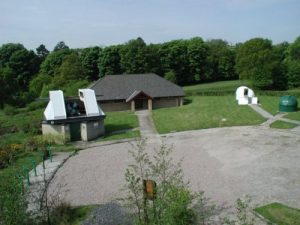
Alston Observatory opened in 1995. This eventually became the main location for undergraduate astronomy teaching at UClan
Alston Observatory has frequently hosted events relating to the BBC series Stargazing Live. Alston observatory has been a participating observatory where the public are invited to come to the observatory to attend a series of talks and view the night sky (weather permitting).
In 2015 on the 16th January, Alston Observatory featured on BBC1 on ‘The One Show’, in a piece entitled ‘The Music of the Spheres’. The show will also feature an interview with UCLan Astrophysicist, Professor Donald Kurtz. The programme discussed Pythagoras’ theory that the planets of our solar system made music as they circled through the heavens. Professor Kurtz’s recent work with the NASA Kepler Space Telescope has allowed him to calculate the manner in which different stars vibrate and ‘ring’ like a bell.
The Moses Holden Telescope was installed in 2016. It is a highly specialised 0.7m diameter mirror Altitude-Azimuth reflecting telescope. It is the largest telescope of its kind at a university in the north of England and the third largest in the UK.
The Moses Holden Telescope is a unique telescope because of its sheer size. Where a smaller telescope can see planets and the moon, this can observe distant galaxies, nebulae, ‘deep sky objects’, details on the surface of the moon, Orion and Jupiter. It is used by our undergraduates rather than postgraduates and PhD students. In addition, local community groups will have the opportunity to use the 2.1 m telescope. Astronomy is very popular field of science locally and as such we do a lot of outreach work with schools, children’s clubs, like the Brownies and Cubs, but also with local astronomical groups and societies. This new telescope means we can show even more of the universe. Created by Planewave, in America, and imported by Green Witch, the telescope was delivered to the Alston site in August 2015. It was delicately craned into the building in two sections before the installation took place over the winter months. It was mounted on a solid concrete plinth, based on foundations more than a metre underground, and isolated from the rest of the building to avoid vibrations. The telescope ‘tube’ is constructed of carbon-fibre rods supporting the secondary mirror while the primary mirror sits in a yoke mount allowing the telescope to rotate both horizontally and vertically.
More infomation about the Moses Holden Telescope can be found on the Alston Observatory and Alston Gallary pages.
Credits
We thank Derek Ward-Thompson, Bob Frost, Stephen Halliwell, Mark Norris and Victor Debattista for their time researching and archiving the infomation presented here. We would like to thank Rory MacDonald and Steven Gough-Kelly for researching and compiling the infomation presented here. We would also like to thank the Preston and District Astronomical Society and Mike Savage for their reference material. Finally we thank Ben Thompson for compiling it into a web-friendly format.
References
‘Moses Holden 1777 – 1864 The Preston Astronomer Who Was Never Eclipsed’ Stephen R. Halliwell – See more at: http://pegasuspublishers.com/shop&book=pb-moses-holden-1777-1864-the-preston-astronomer-who-was-never-eclipsed#sthash.EfoD8G5J.dpuf.
‘A small Celestial Atlas, or Maps of the Visible Heavens, in the Latitude of Britain,’, 1818, M. Holden
G.J. Gibbs: Improvements in Apparatus for Indicating Mean Solar time, UK Patent Application 10,787, 8th May 1906.
G.Aldred: A Review Of The Heliochronometers By Pilkington & Gibbs, Bull BSS, British Sundial Society Bulletin, 18(ii,iii), 90-131 (2006).

